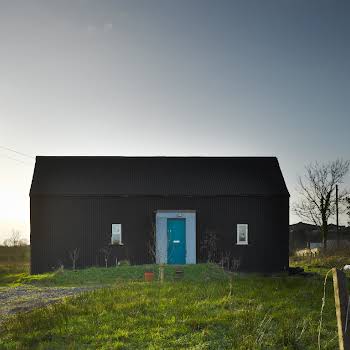
By Amanda Kavanagh
07th Jun 2022
07th Jun 2022
Should I use paint stripper? Should I invest in a heat gun? We put your questions to an expert.
No two ways about it, paint stripping is a pain. A pain that Jessica Smyth of @innercity_victorian knows only too well.
She stripped the front door and fanlight of her Phibsborough home for over five months (!) and has tackled architraves, windows and fireplaces with aplomb. Here she shares some things she’s learned along the way.
A heat gun is great for tackling wood
I use an entry-level, bog-standard brand one, picked up in a local hardware store and it is still going strong 18 months later, even though I have used it a lot. The beauty of a heat gun is that you don’t need to apply anything beforehand, it’s good to go. It’s my go-to method for most woodwork inside and outside the house. However, you really do need to wear a mask, and with disposable masks and respirators in short supply right now, there are other effective approaches to stripping wood you can try.
If you don’t have protective equipment, try a chemical product
The chemical poultice product Peelaway, and similar brands, can dissolve multiple layers of paint very easily and without releasing toxic lead fumes. You can leave this product on for up to 48 hours, but make sure you do a test patch first as it can start to eat into the wood if left on too long. I’ve had best results using this indoors.
For doors, metal fire surrounds, or other removable items, professional dipping or chemical stripping is also an option. Doors can sometimes warp during this process, but if done right the time saving is significant and it’s relatively cost-efficient.
Don’t put a heat gun near a painted cast-iron fireplace, as it can shatter. A chemical poultice product is best for this too.
Scrapers are also essential
I use a few differently-sized flat scrapers, like the ones you use for stripping wallpaper, and a shave hook, which is useful for getting around curves and into nooks and crannies. You can be ad hoc with your tools too; I’ve been using a table knife on parts on our front door surround as it is just pointy and slim enough for the awkward bits.
Protect yourself
If you’re intent on using a heat gun, and can wait till your hardware store is restocked and it’s fair to purchase a mask, you should wear a proper one – at least FFP3 (the highest level of particle filtration) – or ideally one of those ‘gas mask’ type masks with screw in filters. It’s safest to assume there will be lead in your paint, an almost certainty in old houses, and you do not want to inhale lead particles.
Ventilation is also key
Strip pieces outside if possible, while wearing a mask, or open doors/windows for good air through-flow. Goggles or glasses can be useful if the paint is flaky, as it can sometimes ping off and into your eyes when you’re scraping. Gloves can also stop accidental grazes if your scraper slips.
You can easily scorch or burn wood
You can also very easily gouge wood with scrapers, so go gently at first. Work slowly, testing a small patch at a time until you get a feel for how long you need hold the heat gun over a surface and how much pressure you can put on the scraper. Different paint types (e.g. gloss/emulsion/exterior/interior/primer) will all react differently to the heat too, so it’s a bit of trial and error.
It takes way longer than you think it will
Don’t try to be too ambitious. Break the job up into smaller sections, so you can see progress during each stripping session. Also ask yourself if you really need to strip a surface back to the bare wood or will a good sanding suffice? If the paint is thick and obscuring detail you’d like to reveal, then go for it, but be prepared for the long haul. Like most DIY jobs, it will often get worse before it gets better and there may be knock-on jobs like replacing window putty, repairing rotten wood or cracks in masonry.
Split the job down the middle to see progress
I tried this with our front door fanlight and it’s really helped morale. It’s like an instant before and after. It doesn’t have to be exactly half – working in zones can have the same effect.
Restoring cast-iron railings is another slow job
If you want cast-iron railings stripped back to their original glory, and money is no object, you can get them dismantled, brought to a workshop and shot-blasted, before being primed and reassembled on site. The quote for our front railings, including replacement of missing elements, ran into the thousands, so we’re going to attempt stripping them ourselves.
Again, I’ve found the heat gun the most effective way of doing this, but a chipping hammer is great for getting all the loose and flaking paint off first. We’ve been stripping a railing at a time and priming with a zinc-rich primer called Galvafroid as we go.
The most common mistake is underestimating the time it will take
It is easy to get dispirited. Also, using the heat gun on too high a setting, or leaving it on the painted surface too long, which can badly damage the wooden surface beneath. Be careful using the heat gun too close to glass (e.g. window panes or fanlights) as this can crack the glass. If you want to remove paint from glass in a door or window frame, apply a gentle paint stripper like Nitromors and then scrape off with a blunt knife or wire wool.
For more renovation advice and to follow Jessica’s home project, follow @innercity_victorian on Instagram.























